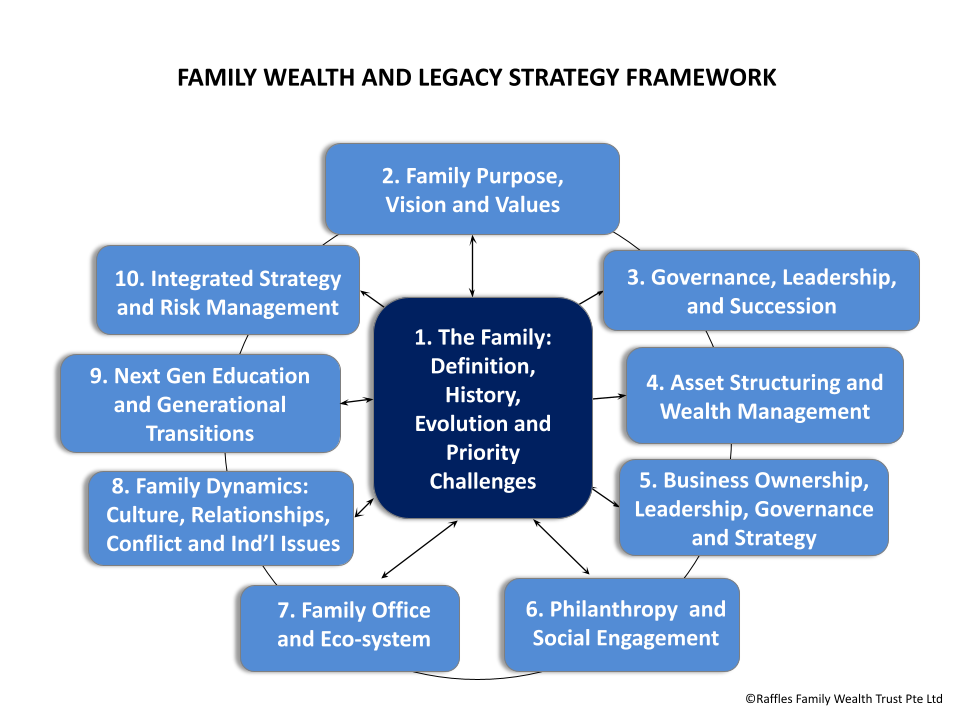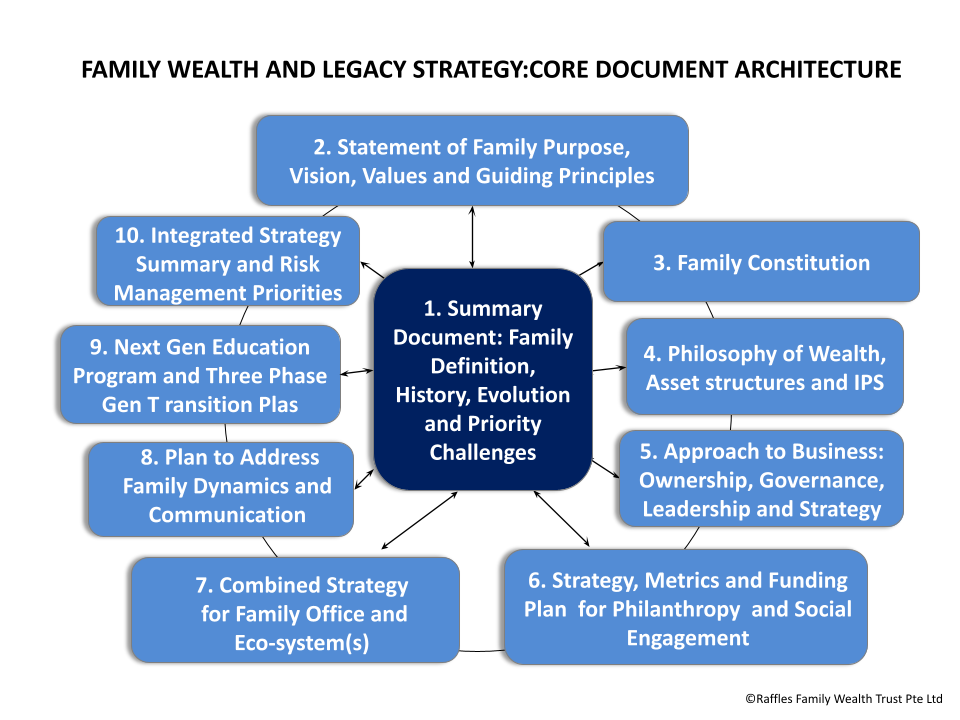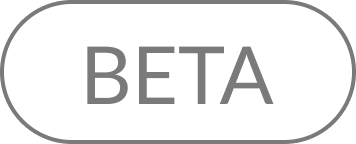The Legacy Strategy Framework and Initial Assessment of Your Own Situation
Unlike a health check, which may involve complicated tests and analyses, a family wealth check to see whether or not your family could benefit from an investment in family strategy is simple, easy and painless. All that is required, no matter how wealthy your family, is a ‘yes’ or ‘no’ answer to three basic questions:
-
Do you have a clear and documented strategy to preserve and enhance your family wealth – in all its dimensions – across
future generations?
-
Do all relevant members of the family understand and support that strategy?
-
Are you implementing that strategy successfully?
If your answer to these three questions is affirmative, you are among the very small minority of families who have properly addressed this important family issue. You should be firmly congratulated for having an effective family wealth strategy in place.
If not sure, or if unfamiliar with the topic, the Integrated Legacy Strategy ™ framework initially described in Mark Haynes Daniell’s classic book Strategy for the Wealthy Family: Seven Principles to Assure Riches to Riches Across Generations, sets out a clear and simple structure, both multi-dimensional and multi-generational in approach, that allows you to review your status against a proven set of interrelated factors:

The Family
At the center of the integrated framework lies the family itself, providing the raison d’être of the strategy and exerting gravitational influence on all constituent elements of that strategy.
The important elements of your integrated legacy strategy related to the family will include an understanding of its history, purpose, vision, values and guiding principles that will inform all aspects of the strategy for both the short and long term.
Family Organization and Leadership
One of the critical elements in developing a multi-generational family wealth strategy, based on the family is an organized approach to the family, its branches, leadership and rising generation.
Family Asset Structuring and Wealth Preservation
Everything from wealth structuring, estate planning, scenario planning, tax management, investment disciplines, spending and distribution patterns, family values, and other elements of a forward-thinking approach to protecting and preserving wealth needs to be considered in developing the right structured approach.
However, expertstructuring alone is unlikely to the desired preservation and enhancement of family financial capital and less supported by a positive family culture and a set of guiding principles which can inform both the investment and distribution of family wealth within and across generations.
Family Wealth Management
Every wealthy family, by definition, has a substantial amount of financial wealth. No matter what the exact amount or how the wealth is held, each family will need to determine its investment profile, set its investment objectives and define a disciplined and high quality investment process in order to make the most of its current assets and future opportunities. This is particularly true for families and individuals who have become suddenly wealthy, or find themselves holding substantial liquid wealth for the first time.
The Family Business (Ownership, Leadership, Governance and Strategy)
A family business, if one exists, may play a central role in the family’s economic fortunes and in its history.
That business can be a major contributor to a wealthy family’s stature in the various communities to which it belongs. A family business can also play a dominant role in the individual careers, personal aspirations, and lifestyles of individual family members.
In addition to playing a central role in family history and family members’ careers, a family business plays a major < de facto role in family wealth management, as the holding creates a major source of value, and brings with it both risks and opportunities in the context of a family’s financial and human capital in equal measure.
Family Risk Management
The notion of family risk is embedded in each of the other individual elements of strategy in the framework, but is also included as a separate element.
Effective risk management requires consolidation, assessment, prioritization and action on a coordinated basis. Physical, family, financial, fiscal, business, investment, concentration, cyber, marital, legal, relationship, cultural and other risks can all have a major effect on a family’s future wealth and well-being.
Even the family office and family eco-system can harbor unsuspected risk: one detailed study of families who lost substantial wealth attributed the greatest number of failures to the presence of a ‘predator in the family ecosystem’ who brought about substantial financial loss and consequent damage to the well-being of the family and the lives of its individual members.
Family Philanthropy and Social Engagement
Many wealthy families, of all categories of wealth, will share some of their good fortune by supporting one or more charitable organizations or philanthropic causes. Some of the wealthiest families may even create their own philanthropic foundations and related organizational entities.
Philanthropy can also play a major role in a family’s history, current identity and future unity. Sharing wealth effectively, and with a clear sense of value and purpose, is an essential element of the strategic framework for any wealthy family.
The Family Office and ‘Eco-System’
None of the strategic elements related to the internal organization of a wealthy family mentioned here can be managed successfully without the support of external resources. Those resources will create an interconnected ‘eco-system’ consisting of individuals, groups, institutions and communities surrounding and connected to the family.
One key part of a family’s ‘eco-system’ may be a dedicated Family Office, usually a professionally managed organization set up to look after many of the family’s interests. This usually includes tax and estate planning, wealth management, family business issues, philanthropic initiatives and the more personal aspects of family service, organization and management.
Family offices are often intimately involved with the preparation of the Next Generation family members and detailed programs of their career development. Leadership succession is essential for successful continuity of family harmony, wealth, business and stature and require effective management before, during and after the actual changes in family, wealth and business ownership, leadership and governance.
Family Dynamics and Individual Family Members
Family culture, relationships, and individual issues are often the major source of strength in creating something greater for the family and its members than they could create on their own, but can also be the major source of friction or conflict that provides serious risk to a family’s future legacy.
Interdependent Elements
The first reason to consider all elements of strategy on an integrated basis is that all elements of the strategy
are inextricably intertwined.
Trust structures and strictures can have an influence on estate plans and wealth management. Philanthropic objectives can have an influence on wealth management and family infrastructure. The family ‘eco-system’ can play a major role in all aspects
of family strategy.
By considering each element on a stand-alone basis, family leaders and strategists will be able to create a series of focused strategies targeted at the achievement of specific objectives in each critical area of family strategy. By integrating these individual strategies into a coherent whole, they will contribute to the creation of an approach where the overall results are far greater than the sum of the individual parts.
Where are We Now?
Family Wealth and Legacy Scorecard
The display below, based on the framework described above, allows you to score your current status in the individual elements and calculate an aggregate score based on your own estimates. Each box has a potential low score of 1 and a high score of 10, with a set of prompts next to each box to give you a sense of definition and content of the item being ranked.
Scoring each of the ten boxes from 1 to 10 shows your cumulative score.
The individual scores by element of the strategy can both assess the current state of affairs by area and on an overall basis, and also provide input into a determination of where your priority actions might best be aimed to increase the individual and aggregate scores to those activities that would have the greatest impact.


Next Steps
As it is our stated purpose to help family leaders both preserve their wealth and strengthen their families over an extended period of time, we hope that the courses and lessons offered here, possibly supplemented by direct interaction with our senior team members as well, could help you to understand, plan, and implement the right set of next steps for you and your family.
Taking advantage of the informed resources and learning opportunities here can be a major step toward the best possible future for your own family, and a great contribution to the wealth and wellbeing of both current and future generations.

